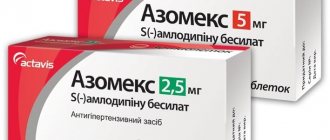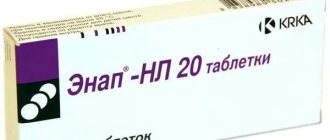Pharmacological properties of the drug Equator
Equator is a combined antihypertensive drug containing two active components. Lisinopril belongs to the group of ACE inhibitors; it reduces the level of angiotensin II and aldosterone in the blood plasma and simultaneously increases the level of bradykinin, which has a vasodilatory effect. Under the influence of lisinopril, peripheral vascular resistance and blood pressure decrease, and IOC and renal blood flow may increase. Heart rate remains virtually unchanged. In patients with hyperglycemia, lisinopril helps restore impaired endothelial function. The antihypertensive effect develops 1 hour after administration, the maximum effect is achieved after 6 hours. The duration of action depends on the dose and is about 24 hours. The effectiveness of lisinopril is maintained with long-term use. When discontinuing therapy, no sharp and intense increase in blood pressure is observed due to drug withdrawal. Although the primary action of lisinopril is through the renin-angiotensin-aldosterone system, its use is also effective when renin levels are low. The use of lisinopril in patients with diabetes mellitus does not cause changes in blood glucose levels. Amlodipine is a calcium ion antagonist, a dihydropyridine derivative. By blocking slow calcium channels of the membrane, it prevents the transmembrane entry of calcium ions into cardiomyocytes and vascular smooth muscle cells. Under its action, vascular tone (arterioles) and peripheral vascular resistance decrease. By dilating arterioles and reducing afterload, amlodipine has an antianginal effect. Due to the fact that it does not cause the development of reflex tachycardia, its use reduces the myocardial oxygen demand. Amlodipine appears to dilate both intact and diseased coronary vessels, improving myocardial perfusion. Amlodipine is well absorbed after oral administration. It is widely distributed in the tissues of the body and is slowly eliminated, which ensures its long-lasting effect and makes it possible to take it once a day for 1 day. In patients with hypertension (arterial hypertension), taking amlodipine once a day significantly reduces blood pressure for at least 24 hours in both the supine and standing positions. The action of amlodipine develops slowly, so the likelihood of developing symptomatic hypotension is small. Amlodipine does not have adverse metabolic effects, including no effect on plasma lipid levels. The drug can be prescribed to patients with asthma, diabetes mellitus and gout. A calcium antagonist can cause an increase in the activity of the renin-angiotensin-aldosterone system, and lisinopril introduced into the drug ensures normalization of the body's response by counter-regulating the renin-angiotensin-aldosterone system. Lisinopril enters the systemic circulation unchanged. The maximum concentration in blood plasma is reached approximately 6 hours after administration. Bioavailability - 29%. Apart from ACE, it does not bind to other plasma proteins. It is not metabolized in the body and is excreted unchanged in the urine. The half-life is 12.6 hours. Free lisinopril is released quickly, and ACE-bound lisinopril is released more slowly, which contributes to the prolonged effect of the drug. In case of kidney disease, excretion slows down, so in this case, a reduction in the dose of the drug may be necessary. Lisinopril is eliminated by hemodialysis. Amlodipine after oral administration is slowly but almost completely absorbed from the digestive tract. Concomitant food intake does not affect its absorption. The maximum concentration in blood plasma is observed 6–10 hours after administration. The bioavailability of amlodipine is 64–80%, the volume of distribution is about 20 l/kg body weight. 95–98% of amlodipine is bound to plasma proteins. Metabolized mainly in the liver to inactive metabolites. About 10% of unchanged substance and 60% of metabolites are excreted in the urine. Elimination is biphasic, the half-life averages 35–50 hours. A stable equilibrium concentration is established after 7–8 days of administration. Amlodipine is not excreted during hemodialysis. The time to reach maximum plasma concentrations is similar in young and elderly patients. In elderly patients, the excretion of amlodipine is slightly reduced, the AUC value and half-life increase. No dose adjustment is required in elderly people. In case of liver pathology, the half-life of amlodipine is prolonged. In case of kidney diseases, the concentration of amlodipine in the blood plasma does not depend on the degree of kidney damage. When taking the drug Equator, there is no interaction between the active components, which is confirmed by pharmacokinetic studies. Important pharmacokinetic parameters (AUC, maximum plasma concentration, time to reach maximum concentration, half-life) did not differ when using active components in combination or separately. The absorption of the active ingredients of Equator does not depend on food intake. Due to the fact that the active components of Equator remain in the body for a long time, the drug can be used once a day.
Active ingredients and pharmacokinetics
Equator tablets are an antihypertensive drug, the main active ingredients of which are lisinopril and amlodipine.
Long-term use of lisinopril has a positive effect on blood supply, myocardial and artery hypertrophy. Lisinopril helps to effectively reduce blood pressure, peripheral vascular resistance, and pressure in the capillaries of the lungs. Begins to act one hour after administration. The maximum effect is achieved after six hours and lasts throughout the day.
After administration, lisinopril enters the bloodstream. It is not metabolized and is excreted in the urine. For a long time it provides a therapeutic effect, maintaining normal blood pressure.
Amlodipine has an antihypertensive effect, lowering blood pressure. Significant improvement is observed 6 hours after oral administration and persists for a day. Amlodipine has a beneficial effect on cardiac activity.
Equator tablets should be taken only as prescribed by a doctor.
Amlodipine is absorbed almost completely from the gastrointestinal tract. Metabolized in the liver. About 10% of the substance is excreted in the urine, 20-25% through the intestines.
The combination of these two active components, amlodipine and lisinopril, in Equator makes it possible to block the development of possible negative consequences caused by one of them.
In addition to lisinopril and amlodipine, the drug tablet contains:
- Sodium carboxymethyl starch;
- Microcrystalline cellulose;
- Magnesium stearate.
Use of the drug Equator
The drug is prescribed if it is not possible to achieve the desired reduction in blood pressure with monotherapy with one of the components included in the drug. The dose of the drug for adults who do not take other antihypertensive drugs is 1 tablet per day, regardless of meals. Patients taking diuretics should stop taking them 2-3 days before starting therapy with Equator. If this is not possible, the initial dose of the drug should be 1/2 t of tablet per day. In this case, after the first dose of the drug, the patient’s condition should be monitored due to the possibility of developing symptomatic hypotension. In case of renal failure, it is recommended to reduce the initial dose of the drug. The maintenance dose is determined individually depending on the response to the drug and subject to sufficiently frequent monitoring of kidney function indicators, potassium and sodium levels in the blood serum. In case of liver failure, the elimination of amlodipine from the body may slow down, so the drug should be used with extreme caution in these patients.
"Equator" during pregnancy
An impressive list of contraindications to taking the drug includes pregnancy. The fact is that the main active ingredient, lisinopril, penetrates the placenta, which can cause developmental disorders of the fetus in the womb:
- decreased blood pressure;
- hypoplasia of the skull;
- renal failure;
- hyperkalemia.
Equator should not be taken during pregnancy.
The baby may die before being born. Therefore, taking Equator during pregnancy is prohibited. The same can be said about breastfeeding - the substances of the drug penetrate into the milk, as a result, during lactation, treatment with Equator or any other drugs that contain lisinopril as a component is prescribed only as a last resort.
Side effects of the drug Equator
Usually transient, mild and rarely require discontinuation of the drug. The most common symptoms are headache, cough and dizziness. Possible weakness, diarrhea, nausea, vomiting, orthostatic hypotension, skin itching and rash, swelling, flushing of the facial skin, chest pain, arthralgia. With increased sensitivity, angioedema of the face, extremities, lips, epiglottis and larynx may develop; in this case, the drug is immediately discontinued, the patient should be under medical supervision until the symptoms completely disappear. When using other drugs of the ACE inhibitor group, the development of agranulocytosis was noted, so the possibility of its occurrence cannot be excluded when using Equator. With long-term use of the drug, hemoglobin and hematocrit levels may decrease slightly. Hyperkalemia, increased levels of creatinine, residual nitrogen, as well as increased activity of liver enzymes and serum bilirubin levels are possible, especially in patients with kidney disease, diabetes mellitus or renovascular hypertension. The following rarely reported side effects are also possible: palpitation, tachycardia, dyspeptic symptoms, dry mouth, abdominal pain, pancreatitis, hepatocellular or cholestatic jaundice, hepatitis, gingival hyperplasia, edema, urticaria, increased sweating, alopecia, impaired renal function, frequent urges to urination, oliguria, anuria, acute renal failure, uremia, proteinuria, impotence. Pathological conditions with the appearance of antibodies to nucleic acids, increased ESR and arthralgia, as well as the appearance of polymorphic (exudative) erythema are described.
Special instructions for the use of the drug Equator
The drug may cause significant symptomatic hypotension in patients with hyponatremia and/or hypovolemia caused by taking diuretics or dehydration due to another reason (intense sweating, prolonged vomiting, diarrhea). If hypotension occurs, the patient should be placed in a horizontal position and, if necessary, replenish the fluid deficiency (infusion of isotonic sodium chloride solution). Before prescribing the drug, it is necessary to eliminate hyponatremia or hypovolemia, and when taking the first doses of the drug, monitor blood pressure levels. In patients with aortic stenosis or hypertrophic cardiomyopathy, Equator, like other vasodilators, should be used with caution due to the narrowing of the outflow tract. In case of renal artery stenosis (especially bilateral or solitary kidney), in the presence of hyponatremia and/or hypovolemia, as well as in case of circulatory failure, the use of lisinopril can lead to impaired renal function up to acute renal failure (usually reversible and goes away after discontinuation of the drug). When taking any ACE inhibitor, including lisinopril, angioedema of the face, extremities, lips, epiglottis and larynx may develop. In this case, you must immediately discontinue the drug. For swelling localized to the face, lips and limbs, the use of antihistamines is indicated. Angioedema of the tongue, larynx or epiglottis can be fatal due to mechanical asphyxia, therefore, if it develops, urgent therapeutic measures should be taken: administer 0.3–0.5 ml of 0.1% epinephrine (adrenaline) solution (0.3 –0.5 mg subcutaneously or 0.1 ml (0.1 mg) intravenously slowly, prescribe corticosteroids and antihistamines, monitor the vital functions of the body. When using anesthetics that cause hypotension, lisinopril inhibits the compensatory release of angiotensin II. The hypotension that occurs in this case can be eliminated by administering an isotonic solution of sodium chloride. Carrying out hemodialysis using a polyacrylonitrile membrane (for example AN 69) in a patient taking an ACE inhibitor can lead to the development of anaphylactic shock, so their simultaneous use should be avoided. A different type of filter should be used or an antihypertensive drug of a different group should be prescribed. In some patients taking an ACE inhibitor, during desensitization to the venom of Hymenoptera insects, anaphylactic reactions occurred that were life-threatening. Their development can be avoided by temporarily interrupting the course of treatment with an ACE inhibitor. Due to the fact that the possibility of developing agranulocytosis cannot be unequivocally excluded, it is necessary to monitor the cellular composition of the blood during the treatment period. When using both active ingredients of the drug in usual doses in elderly patients, no decrease in effectiveness was detected, although their higher concentration in the blood plasma was noted, and therefore the dose of the drug in these patients should be selected with caution. With liver damage, the half-life of amlodipine increases, so the drug should be used with caution, individually assessing the expected effect and risk of therapy. During pregnancy and breastfeeding, the use of lisinopril, as well as other ACE inhibitors, is contraindicated; If pregnancy occurs, Equator should be discontinued immediately. The use of Equator during breastfeeding is not indicated, since lisinopril is excreted in breast milk. The drug may affect the ability to drive vehicles or operate potentially dangerous machinery (especially during the initial period of treatment), so this effect of the drug should be assessed individually.
Analogs
The closest analogue of "Equator" is the drug "Equacard", containing the same active ingredients - amlodipine (5 mg) and lisinopril (10 mg) in one tablet. Also a related drug is Eclamise.
All drugs are based on the interaction of two main components. They can be found separately, Amlodipine and Lisinopril tablets in different release forms and from different manufacturers.
The following drugs are also similar in action:
- "Perestance"
- "Enanorm"
- "Egipres"
- "Triapin"
- "Dalneva"
- "Coriprene"
- "Enal L CombI".
If side effects occur when taking Equator, it is usually changed to one of the above drugs.
Drug interactions Equator
The drug is used with extreme caution in combination:
- with potassium-sparing diuretics (for example, spironolactone, amiloride, triamterene), with potassium and table salt containing potassium. In this case, hyperkalemia may develop, especially with impaired renal function, so the drug can be prescribed only after a careful assessment of the benefit-risk ratio of therapy, subject to regular monitoring of serum potassium levels and renal function indicators;
- with allopurinol, cytostatics, immunosuppressants, corticosteroids, procainamide, since their combination with lisinopril can lead to the development of leukopenia.
Use with caution at the same time:
- with diuretics: a sharp decrease in blood pressure may be noted;
- with other antihypertensive drugs (additive effect);
- with NSAIDs (reduced antihypertensive effectiveness);
- with lithium salts (lithium accumulation may occur, so its level in the blood plasma should be regularly monitored);
- narcotic drugs, anesthetics (strengthen the hypotensive effect of lisinopril).
Lisinopril reduces potassium excretion when combined with diuretics. Lisinopril increases the manifestations of alcohol intoxication. No interactions between lisinopril and amlodipine have been identified.
Ekvator®
Amlodipine
Contraindicated combinations of drugs
Dantrolene (intravenous administration)
In laboratory animals, cases of ventricular fibrillation with death and collapse have been reported during the use of verapamil and intravenous dantrolene, accompanied by hyperkalemia. Due to the risk of developing hyperkalemia, concomitant use of slow calcium channel blockers, including amlodipine, should be avoided in patients susceptible to malignant hyperthermia, as well as during the treatment of malignant hyperthermia.
Not recommended drug combinations
Grapefruit juice
Taking amlodipine with grapefruit or grapefruit juice is not recommended as the bioavailability of amlodipine may be increased in some patients, resulting in increased blood pressure lowering effects.
Combinations of drugs that require special caution when used
Inducers of the CYP3A4 isoenzyme
With simultaneous use of known CYP3A4 inducers, the concentration of amlodipine in the blood plasma may fluctuate. For this reason, it is necessary to both monitor blood pressure and adjust the dose of the drug during and after concomitant use, especially with strong CYP3A4 inducers (for example, rifampicin, St. John's wort (Hypericum perforatum) preparations).
CYP3A4 isoenzyme inhibitors
Concomitant use of amlodipine and strong or moderate inhibitors of CYP3A4 (protease inhibitors, for example, ritonavir, azole antifungals, macrolides, for example, erythromycin or clarithromycin, verapamil or diltiazem) can lead to a significant increase in amlodipine concentrations. Clinical manifestations of these pharmacokinetic abnormalities may be more pronounced in elderly patients. In this regard, monitoring of the clinical condition and dose adjustment of the Equator® drug may be required.
Combinations of drugs that require caution when used
Simvastatin
Repeated administration of amdodipine at a dose of 10 mg in combination with simvastatin at a dose of 80 mg resulted in an increase in simvastatin exposure by 77% compared with simvastatin monotherapy. Therefore, patients receiving amlodipine should take simvastatin at a daily dose of no more than 20 mg.
Calcium preparations
May reduce the effect of BMCC.
Lithium preparations
When BMCC is used together with lithium preparations (no data are available for amlodipine), their neurotoxicity (nausea, vomiting, diarrhea, ataxia, tremor or tinnitus) may increase.
Baclofen
Strengthening the antihypertensive effect. Blood pressure and renal function should be monitored, and the dose of amlodipine should be adjusted if necessary.
Amifostin
The antihypertensive effect of amlodipine may be enhanced.
Glucocorticosteroids
Decreased antihypertensive effect (retention of fluid and sodium ions as a result of the action of corticosteroids).
Tricyclic antidepressants, antipsychotics
There is an increased risk of orthostatic hypotension and increased antihypertensive effect (additive effect).
Tacrolimus
When used simultaneously with amlodipine, there is a risk of increasing the concentration of tacrolimus in the blood plasma. To avoid toxicity of tacrolimus when used concomitantly with amlodipine, the concentration of tacrolimus in the blood plasma of patients should be monitored and the dose of tacrolimus should be adjusted if necessary.
Tasonermin
With simultaneous use, amlodipine may increase the systemic exposure of tasonermin in blood plasma. In such cases, regular monitoring of tasonermin in the blood and dose adjustment if necessary is necessary.
Other interactions with amlodipine
For the treatment of arterial hypertension, amlodipine can be safely used with thiazide diuretics, alpha-blockers, beta-blockers and ACE inhibitors.
In patients with stable angina, simultaneous use of amlodipine with other antianginal drugs, such as long- and short-acting nitrates, beta-blockers, is possible.
It is possible that the antianginal and antihypertensive effects of BMCC may be enhanced when used simultaneously with thiazide and loop diuretics, ACE inhibitors, beta-blockers and nitrates, as well as their antihypertensive effect is enhanced when prescribed with alpha-1-blockers and antipsychotics.
Amlodipine does not cause a negative inotropic effect. However, some CBMCs may increase the negative inotropic effect of antiarrhythmic drugs that cause QT prolongation (eg, amiodarone and quinidine).
Unlike other BMCCs, no significant interaction was detected between amlodipine (3rd generation BMCC) and NSAIDs, including indomethacin.
It is safe to administer amlodipine with oral hypoglycemic agents.
A single dose of sildenafil in a dose of 100 mg in patients with essential arterial hypertension had no effect on the pharmacokinetics of amlodipine.
Combined repeated administration of amlodipine at a dose of 10 mg and atorvastatin at a dose of 80 mg led to an insignificant change in the pharmacokinetic parameters of atorvastatin at steady state.
Ethanol (drinks containing alcohol): amlodipine does not have a significant effect on the pharmacokinetics of ethanol with single or repeated use at a dose of 10 mg.
Interaction studies between cyclosporine and amlodipine have not been conducted in healthy volunteers or in special groups of patients, with the exception of patients after kidney transplantation. Various studies of the interaction of amlodipine with cyclosporine in patients after kidney transplantation show that the use of this combination may not lead to any effect, or increase the minimum concentration of cyclosporine to varying degrees, up to 40%. Cyclosporine concentrations should be monitored in patients after kidney transplantation.
With simultaneous use of amlodipine and digoxin, the renal clearance and concentration of digoxin in the blood serum do not change.
With simultaneous use of warfarin with amlodipine, the prothrombin time does not change.
When used simultaneously with cimetidine, the pharmacokinetics of amlodipine does not change.
Amlodipine does not affect the degree of binding of digoxin, phenytoin, warfarin and indomethacin to plasma proteins in vitro.
Aluminum and magnesium-containing antacids: a single dose of such antacids together with amlodipine does not have a significant effect on the pharmacokinetics of amlodipine.
mTOR inhibitors (mammalian Target of Rapamycin - target of rapamycin in mammalian cells)
mTOR inhibitors (eg, temsirolimus, sirolimus, everolimus) are CYP3A4 substrates. Because amlodipine is a weak CYP3A4 inhibitor, concomitant use may increase exposure to mTOR inhibitors.
Lisinopril
Contraindicated drug combinations
Aliskiren
Concomitant use of ACE inhibitors with aliskiren and aliskiren-containing drugs in patients with diabetes mellitus and/or moderate or severe renal impairment (GFR less than 60 ml/min/1.73 m2 body surface area) is contraindicated.
The administration of ACE inhibitors with angiotensin II receptor antagonists is contraindicated in patients with diabetic nephropathy.
Not recommended drug combinations
Angiotensin II receptor antagonists (ARA II)
The literature has reported that in patients with established atherosclerotic disease, chronic heart failure, or diabetes mellitus with end-organ damage, concomitant therapy with an ACE inhibitor and an ARB II is associated with a higher incidence of hypotension, syncope, hyperkalemia, and deterioration of renal function (including acute renal failure) compared with the use of only one drug that affects the RAAS. Dual blockade (for example, when combining an ACE inhibitor with an ARB II) should be limited to selected cases with careful monitoring of renal function, potassium levels and blood pressure.
Potassium supplements, potassium-sparing diuretics (spironolactone, triamterene, amiloride, eplerenone) or potassium-containing salt substitutes
Hyperkalemia may develop (with possible death), especially if renal function is impaired (additional effects associated with hyperkalemia). ACE inhibitors should not be used concomitantly with substances that increase plasma potassium levels, except in cases of hypokalemia. The combination of lisinopril and the above agents is not recommended. If, however, concomitant use is indicated, they should be used with caution and regular monitoring of serum potassium levels.
Lithium preparations
With the simultaneous use of lithium preparations and ACE inhibitors, a reversible increase in the concentration of lithium in the blood serum and associated toxic effects may be observed. The simultaneous use of lisinopril and lithium preparations is not recommended. If such therapy is necessary, the concentration of lithium in the blood serum should be regularly monitored.
Combinations of drugs that require special caution when used
Insulin and oral hypoglycemic agents
Epidemiological studies have shown that the combined use of ACE inhibitors and hypoglycemic agents (insulins, oral hypoglycemic agents) can enhance their hypoglycemic effect up to the development of hypoglycemia. This effect is most likely to be observed during the first weeks of concomitant therapy, as well as in patients with impaired renal function.
Baclofen
Enhances the antihypertensive effect of ACE inhibitors. Blood pressure levels should be carefully monitored and, if necessary, the dose of antihypertensive drugs should be adjusted.
Diuretics
In patients taking diuretics, especially those that remove fluid and/or salts, a significant decrease in blood pressure may be observed when initiating therapy with an ACE inhibitor. The risk of developing antihypertensive effects can be reduced by discontinuing the diuretic and replacing fluid or salt losses before starting ACE inhibitor therapy. For arterial hypertension in patients with previous diuretic therapy, which could lead to excessive excretion of fluid and/or salts, diuretics should be discontinued before using Equator®.
Renal function (creatinine concentration) should be monitored in the first weeks of using Equator®.
Nonsteroidal anti-inflammatory drugs (NSAIDs), including acetylsalicylic acid at a dose of ≥3 g/day
The simultaneous use of ACE inhibitors with NSAIDs (acetylsalicylic acid in a dose that has an anti-inflammatory effect, cyclooxygenase-2 (COX-2) inhibitors and non-selective NSAIDs) may lead to a decrease in the antihypertensive effect of ACE inhibitors. The simultaneous use of ACE inhibitor drugs and NSAIDs may lead to deterioration of renal function, including the development of acute renal failure and an increase in serum potassium, especially in patients with reduced renal function. Caution should be exercised when prescribing this combination, especially in elderly patients. Patients need to compensate for fluid loss and carefully monitor renal function, both at the beginning of treatment and during treatment.
Estramustine, mTOR inhibitors (sirolimus, everolimus, temsirolimus), neutral endopeptidase inhibitors (omapatrilat, ilepatril, daglutril, sacubitril)
Concomitant use with ACE inhibitors is accompanied by an increased risk of developing angioedema.
DPP-4 inhibitors (gliptins)
Linagliptin, saxagliptin, sitagliptin, vildagliptin: when used together with ACE inhibitors, the risk of angioedema increases due to the suppression of dipeptidyl peptidase-4 (DPP-IV) activity by gliptin.
Neutral endopeptidase inhibitors (NEP)
An increased risk of angioedema has been reported with concomitant use of ACE inhibitors and racecadotril (an enkephalinase inhibitor).
When ACE inhibitors are used simultaneously with drugs containing sacubitril/valsartan, the risk of developing angioedema increases, and therefore the simultaneous use of these drugs is contraindicated. ACE inhibitors should be prescribed no earlier than 36 hours after discontinuation of drugs containing sacubitril/valsartan. The use of drugs containing sacubitril/valsartan is contraindicated in patients receiving ACE inhibitors, as well as within 36 hours after discontinuation of ACE inhibitors.
Combinations of drugs that require caution when used
Other antihypertensive agents (eg, beta blockers, calcium channel blockers, diuretics) and vasodilators
The antihypertensive effect of the drug may be enhanced. Caution should be exercised when administered concomitantly with nitroglycerin, other nitrates or other vasodilators, as this may further reduce blood pressure.
Antacids and cholestyramine
Concomitant use with antacids and cholestyramine leads to suppression of gastrointestinal absorption.
Tricyclic antidepressants, neuroleptics, general anesthesia, barbiturates, phenothiazine, ethanol
When taken together, the effect of lisinopril may be enhanced.
Sympathomimetics
Sympathomimetics may reduce the antihypertensive effect of ACE inhibitors.
Muscle relaxants
The simultaneous use of muscle relaxants with ACE inhibitors can lead to a pronounced decrease in blood pressure.
Gold preparations
When using ACE inhibitors, including lisinopril, in patients receiving intravenous gold (sodium aurothiomalate), rare cases of nitrite reactions (a symptom complex that includes facial flushing, nausea, dizziness and hypotension, which can be very severe) have been described after administration of an injectable drug containing gold (eg, sodium aurothiomalate) has been reported more frequently in patients receiving treatment with ACE inhibitors.
Co-trimoxazole (sulfamethoxazole and trimethoprim)
Increased risk of developing hyperkalemia.
Selective serotonin reuptake inhibitors (escitalopram, paroxetine, fluoxetine, sertraline)
When used simultaneously with SSRIs, severe hyponatremia may develop.
Allopurinol, procainamide, cytostatics (5-fluorouracil, vincristine, docetaxel)
Leukopenia may develop.
Tissue plasminogen activators (alteplase, reteplase, tenecteplase)
Increased risk of angioedema when used simultaneously with ACE inhibitors. Observational studies have shown an increased incidence of angioedema in patients taking ACE inhibitors following the use of alteplase for thrombolytic therapy of ischemic stroke.
Overdose of the drug Equator, symptoms and treatment
It may manifest itself as a pronounced dilatation of peripheral vessels, accompanied by an excessive decrease in blood pressure and reflex tachycardia. The patient is placed in a horizontal position with the lower limbs raised, heart function, blood pressure, and water-electrolyte balance are monitored; if necessary, these indicators are corrected and symptomatic treatment is carried out. In case of severe hypotension, intravenous infusion solutions are prescribed; in case of insufficient effectiveness, peripherally acting vasopressors are prescribed. To eliminate the effects of blockade of calcium channels, intravenous administration of calcium gluconate is indicated. Due to the slow absorption of amlodipine in the gastrointestinal tract, gastric lavage can be effective. Lisinopril is excreted from the body during hemodialysis, but amlodipine is not excreted during hemodialysis due to its high degree of binding to plasma proteins.




